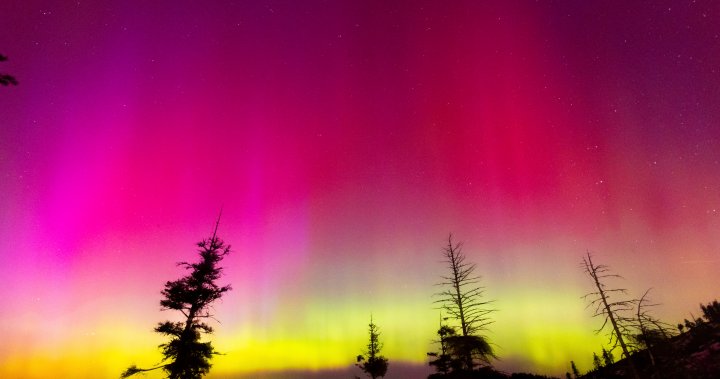A severe geomagnetic storm on May 10 and 11 led to a spectacular display of the aurora borealis across Canada and other parts of the world. The northern lights were visible in various colors such as green, pink, yellow, and blue, captivating observers throughout the night. This storm was considered the most severe in the last 20 years, triggered by solar flares from a massive cluster of sunspots on the Sun. Space weather forecasters issued a notice of the storm on Thursday, warning that it could potentially disrupt infrastructure.
Among the potential disruptions caused by the geomagnetic storm, satellite internet provider Starlink cautioned its customers about possible “degraded service” on Saturday. Despite this warning, owner Elon Musk reassured the public that the satellites were holding up well under the pressure of the storm. The U.S. National Oceanic and Atmospheric Administration (NOAA) space forecaster Robert Steenburgh highlighted the aurora borealis as the most visible manifestation of space weather. He encouraged people in dark, cloud-free areas to witness the impressive display, describing it as the “gift of space weather” that can be truly breathtaking.
The beauty of the aurora borealis on display during the geomagnetic storm was captured through photographs and videos shared by people across Canada and beyond. The stunning views of the colorful lights dancing across the night sky added to the awe and wonder of this natural phenomenon. The rarity and intensity of this particular geomagnetic storm contributed to the heightened excitement and interest among skywatchers and astronomy enthusiasts. The aesthetic appeal of the aurora borealis, coupled with its scientific significance, made this event a memorable and extraordinary experience for many.
The impact of space weather events such as geomagnetic storms extends beyond the visual spectacle of the aurora borealis. These phenomena can have tangible effects on technological infrastructure, including satellite communication systems. Providers like Starlink have to monitor and assess the potential risks posed by such storms to ensure the continuity and quality of their services. Elon Musk’s acknowledgment of the challenges faced by the satellites during the storm highlighted the importance of resilience and preparedness in the face of space weather hazards.
As the geomagnetic storm continued to unfold, scientists and researchers monitored its progression and effects on Earth’s atmosphere and technology. Space weather forecasting plays a crucial role in predicting and mitigating the impacts of solar activity on our planet. By tracking solar flares and sunspot activity, experts can issue warnings and advisories to help safeguard vulnerable systems and infrastructure. The collaboration between space agencies, meteorological organizations, and telecommunications companies underscores the interdisciplinary nature of space weather research and preparedness efforts.
The widespread visibility and accessibility of the aurora borealis during the recent geomagnetic storm offered a unique opportunity for people to connect with and appreciate the wonders of space and Earth’s magnetic field. The enchanting beauty of the northern lights serves as a reminder of the intricate interplay between the Sun, Earth, and our atmosphere. While geomagnetic storms can pose challenges to technology and satellite operations, they also provide moments of awe and inspiration for skywatchers and stargazers. The convergence of science, technology, and nature in events like these showcases the dynamic and ever-changing interactions that shape our understanding of the universe.


